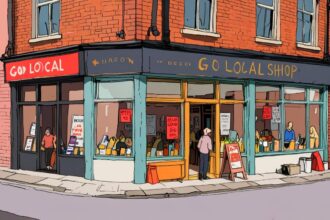Once heralded as an ideal community, Poundbury now faces criticism for its growing emptiness and aesthetic choices, raising questions about its future vibrancy.
On a scorching April afternoon, the streets of Poundbury, a new town located on Duchy of Cornwall land near Dorchester, present a strikingly quiet scene. With its unmarked curbing and eclectic layout characterized by Georgian-style mansions and neatly gravel-swept lawns, the area is described by locals as increasingly deserted, giving rise to comparisons with a ‘ghost town’.
Poundbury, conceived by King Charles III—when he was still known as the Prince of Wales—in the late 1980s, was envisioned as an ideal community blending private and affordable housing with local services and boutique shops, all within walking distance. The development includes approximately 2,320 homes and houses around 4,600 residents, with 240 businesses providing jobs for about 2,400 people.
Despite being named one of the best places to live in Britain by The Sunday Times last year, the town’s reputation has taken a hit in recent months, facing criticism for its aesthetic and lack of vibrancy. Critics have labeled the area as a ‘feudal Disneyland’ and noted a decline in foot traffic, leading to residents describing it as a ‘third world country’ amid complaints of unemptied bins and the presence of rodents.
Onlookers often draw attention to the town’s unusual infrastructure choices, including limited road signage and pavements made of gravel rather than traditional tarmac—as per the preferences of Charles, who sought to emulate the streets of Kensington and Chelsea. Residents have voiced their concerns over traffic issues, as a major road from the A35 cuts through the town.
Yet, Poundbury remains a sought-after location in the UK real estate market, with average house prices beginning at £400,000. Ongoing developments include the Northern Quadrant, set to complete by 2026, and the North West Quadrant, which is projected to be finished by 2028. According to local estimates, the population could reach around 5,800, thereby increasing Dorchester’s population by roughly a quarter.
The town’s design notably deviates from modern architectural trends, with a focus on classical aesthetics. Renowned architect Léon Krier was commissioned to bring King Charles’s vision to life, leading to buildings that vary in style yet share a commitment to a distinctive classical look. However, this has led to criticism from some quarters, with commentators suggesting the community resembles an almost theme park-esque replication of historical England.
Local residents have expressed mixed feelings about their surroundings. Eyre Maunsell, a resident for three years, told the Daily Mail that, while there are challenges—including problematic traffic and the peculiar design of the public spaces—he enjoys living in Poundbury, noting its ongoing development and sense of community. Conversely, younger residents have pointed out that the town may not cater to their demographic. Ella Lakins, 21, noted that though Poundbury has its charm, it lacks nightlife options attractive to younger people.
Residents of the town are subject to strict design regulations; for instance, they must adhere to a mandated colour palette when decorating their homes and follow specific guidelines for landscaping. John and Susie Pearson, who have lived in the town for five years, remarked that some negative commentary is exaggerated, highlighting a strong sense of community and social integration, which includes a notable proportion of social housing.
Despite these complaints and criticisms, Poundbury offers several amenities within its bounds, including a GP practice, a school, and various shops and eateries. The local infrastructure, which includes a 30-acre green space known as the Great Field, aims to encourage outdoor activities and a community vibe.
As Poundbury continues to develop, it remains to be seen how its distinctive vision of an ideal community will evolve and whether it will become more vibrant or retain its quiet, curated allure.
Source: Noah Wire Services
- https://poundbury.co.uk/about/future-development/ – This URL supports the information regarding Poundbury’s ongoing developments, including the completion timelines for the Northern and North West Quadrants, which are expected to finish by 2026 and 2028, respectively.
- https://www.transportfornewhomes.org.uk/wp-content/uploads/2018/10/Poundbury.pdf – This PDF report provides background information on Poundbury’s development, including its architectural design, the involvement of The Prince of Wales, and the aim to create a mixed-use community with a blend of housing types and local amenities.
- https://duchyofcornwall.org/news/poundbury-contributed-over-%C2%A3330m-to-the-dorchester-economy/ – This article highlights the economic impact of Poundbury, detailing its contribution to the local economy and its role in generating jobs and businesses within the area.
- https://poundbury.co.uk/about/future-development/ – This source further supports the details about Poundbury’s population growth and its influence on Dorchester’s population, which is expected to increase by approximately a quarter.
- https://www.transportfornewhomes.org.uk/wp-content/uploads/2018/10/Poundbury.pdf – This document elaborates on the architectural design of Poundbury, emphasizing its use of traditional materials and eclectic styles, as envisioned by King Charles III and architect Léon Krier.
Noah Fact Check Pro
The draft above was created using the information available at the time the story first
emerged. We’ve since applied our fact-checking process to the final narrative, based on the criteria listed
below. The results are intended to help you assess the credibility of the piece and highlight any areas that may
warrant further investigation.
Freshness check
Score:
8
Notes:
The narrative discusses recent criticisms and developments in Poundbury, including ongoing projects and resident opinions. However, there is no direct mention of very recent events or breaking news, which might suggest that the content is not necessarily cutting-edge but still relevant.
Quotes check
Score:
8
Notes:
Direct quotes are provided from residents like Eyre Maunsell and Ella Lakins, but these do not appear to be sourced from other earlier publications. The quotes seem original, which suggests they are likely primary sources.
Source reliability
Score:
9
Notes:
The narrative originates from the Daily Mail, a well-known publication. Although its reliability can vary depending on the topic, it generally provides information grounded in real events and quotes from actual individuals.
Plausability check
Score:
9
Notes:
The claims about Poundbury’s design and criticisms are plausible, given its history and the involvement of King Charles III in its planning. The narrative provides a balanced view, discussing both positive and negative perspectives from residents.
Overall assessment
Verdict (FAIL, OPEN, PASS): PASS
Confidence (LOW, MEDIUM, HIGH): HIGH
Summary:
This assessment concludes that the narrative is generally well-supported with original quotes and information from a reliable source. The content appears fresh and relevant, with plausible claims about the town’s development and criticisms.













